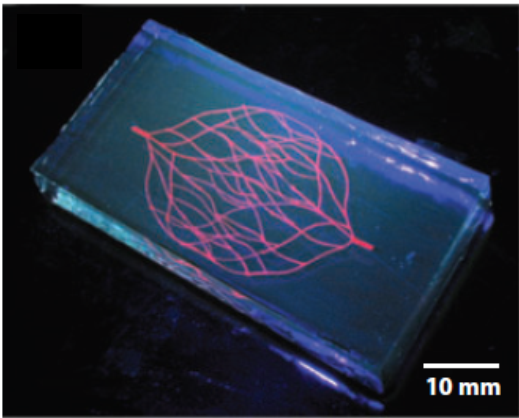The establishment of a functional and hierarchical micro-vasculature is fundamental for tissue engineering as current limitations on mass transport, in particular of nutrients, oxygen, and waste products prevent the development of tissues at clinically relevant dimensions. Vasculature is also relevant to other problems in tissue engineering, such as surgical implantation and in vivo integration, since anastomosis (the reconnection of blood vessels) is considered important to the viability of most implanted tissues. Rapid prototyping techniques show promise in producing 3D microvasculature (Figure 1) but are limited by the choice of materials useful for cellular growth and implantation. This exploratory study will focus on rapid prototyping techniques for production of 3D vascularised collagen constructs with the potential to achieve anastomosis in vivo with the host vasculature.

Figure 1: Fabrication of 3D micro-vascular network [1].
[1] W. Wu, A. Deconinck, J.A. Lewis (2011), “Omnidirectional Printing of 3D Microvascular Networks”, Advanced Materials, Volume 23, Issue 24, p. H178–H183
| Dr. Athina Markaki |
Department of Engineering |
| Dr. Roger Brooks |
Department of Surgery |
 Figure 1: Fabrication of 3D micro-vascular network [1].
[1] W. Wu, A. Deconinck, J.A. Lewis (2011), “Omnidirectional Printing of 3D Microvascular Networks”, Advanced Materials, Volume 23, Issue 24, p. H178–H183
Figure 1: Fabrication of 3D micro-vascular network [1].
[1] W. Wu, A. Deconinck, J.A. Lewis (2011), “Omnidirectional Printing of 3D Microvascular Networks”, Advanced Materials, Volume 23, Issue 24, p. H178–H183
 Figure 1: Fabrication of 3D micro-vascular network [1].
[1] W. Wu, A. Deconinck, J.A. Lewis (2011), “Omnidirectional Printing of 3D Microvascular Networks”, Advanced Materials, Volume 23, Issue 24, p. H178–H183
Figure 1: Fabrication of 3D micro-vascular network [1].
[1] W. Wu, A. Deconinck, J.A. Lewis (2011), “Omnidirectional Printing of 3D Microvascular Networks”, Advanced Materials, Volume 23, Issue 24, p. H178–H183